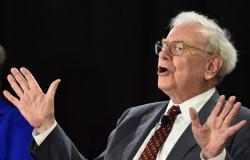
Everything is ready for the Governing Council of the European Central Bank (ECB) announce today a reduction in interest rates 25 basis pointsuntil placing the price of money in the 4.25%. A cut that analysts and markets discount and with which the Eurobank is ahead of the curve for the first time in history. Federal Reserve (Fed) of the United States which, for the moment, rules out a rate cut.
With the new movement expected for today, the European supervisor gives the starting signal for lowering interest rates almost two years after it began a up cycle with ten consecutive comebacks, from July 2022 to September 2023, which has led him to place the reference rate for your refinancing operations at 4.50%, the deposit rate, in 4%, and that of loan facility, at 4.75%.
Today’s descent will be the first in eight yearssince in March 2016 the European supervisor reduced the price of money from 0.05% to 0%.
The interest rate reduction that will begin today will continue throughout the year, but “slowly,” analysts say. Most suggest that the ECB will carry out two new cuts of 25 basis points each one until the end of December 2024, but they do not rule out that one more may occur.
“We expect the ECB to cut all three official interest rates by 25 basis points this week. They should be the first 25 basis points of the 200 that we foresee that occur between June 2024 and July 2025″, points out Rubén Segura-Cayuela, Bank of America’s chief economist for Europe. In his opinion, the supervisor’s next downward movement after June will be in September.
For their part, analysts from the Natixis group’s fund manager Loomis Sayles, emphasize that “a prolonged cycle of ECB cuts is not a fact.” He argues that Europe faces some uncertainties persistent that can prevent inflation from falling and that interest rates experience significant drops due to factors such as a possible improvement in the economy, high unit labor costs, geopolitical uncertainty and fiscal policy.
One of the catalysts that has prompted those responsible for the ECB to lower interest rates has been the good performance of the inflationwhich is getting closer to its 2% target after the annual maximum of 10.6% reached in October 2022 and drop in May of this year to 2.6%. The same trend has followed Underlying inflationwhich after reaching a maximum of 5.7% in March 2023, fell to 2.9% last May.
“Although the fall in inflation has been notable, the ECB should remain attentive to the possible secondary effects after the increase in wages-negotiated rose 4.7% in the euro zone in the first quarter- and the evolution of other costs, such as maritime transport, which has been affected by the Red Sea crisis,” he indicates. Franck DixmierGlobal CIO of Fixed Income at Allianz Global Investors.
With the change of course of its monetary policy, the ECB is ahead of the Fed in the lowering of interest rates that, for the moment, chooses to keep them stable.
“The Fed needs the economy to slow down, which does not imply that it enters a recession, so that the inflation ends moderating before we can start lowering rates. Although this scenario is somewhat harder for investors to assimilate, it is the most likely,” he points out. Juan José Fernández-Figares, Director of Collective Investment Institutions Management at Link Securities.
At its May meeting, the United States Federal Reserve kept interest rates unchanged in the range from 5.25% to 5.5%leaving them in their highest value in 23 years due to the “lack of progress” to lower inflation to the 2% target.
In this economic context, those responsible for the ECB, including its president Christine Lagarde, have defended the independence of the eurobank from the Fed when modifying interest rates.
Furthermore, before the ECB, other central banks have given the Fed a surprise and have initiated rate cuts, including the Swiss National Bank or Riksbank of Sweden. Others such as Australia and New Zealand could lag behind the Federal Reserve as they begin their cutting cycle, while Japan is pricing in rate hikes.
This dispersion among central banks has contributed to a performance differentiation between currencies and American dollar has remained among those of better performance in so far this year.
“The dollar continues to appear as a safe haven“, indicate from Loomis Sayles. They argue that different macroeconomic factors, “from global growth, China and geopolitics, to the debate around the Federal Reserve, Treasury yields, US growth and inflation, “They have supported the US dollar”.
For their part, Mutuativos predict that an immediate consequence of the European supervisor’s interest rate cut will be to have a weaker euro against other currencies such as the dollar, since “by lowering the price of money in Europe, devalues the euro against the dollar”. This will make it more expensive for eurozone countries to import products from the United States.
Jumana Saleheenchief economist at Vanguard Europe, also warns that the divergence between the ECB and the Fed when it comes to lowering interest rates, “could greatly weaken the single currency against the dollarwith a potential upside risk to inflation that would force the ECB to be more cautious.”
Although it is very unlikely, the Governing Council could decide today to maintain the price of money at 4.5%, which, in addition to stupefying analysts, would impact the markets.
“It could cause a fall in stock prices and especially bondsmainly those of the State, since they are more sensitive to expectations of a more restrictive monetary policy,” he explains. Nicolò Bragazzaassociate portfolio manager at Morningstar Investment Management.
Also the markets variable income would be affected, especially the sectors related to public servicesthe sector real estate and the consumer discretionary goods, estimates the Morningstar manager.





